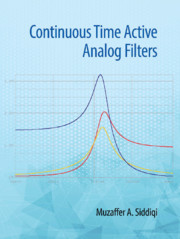Book contents
- Frontmatter
- Dedication
- Contents
- Preface
- Acknowledgments
- 1 Analog Filter: Concepts
- 2 First-and Second-order Filters
- 3 Magnitude Approximations
- 4 Delay: Approximation and Optimization
- 5 Frequency and Impedance Transformations
- 6 Sensitivity of Active Networks
- 7 Single Amplifier Second-order Filters
- 8 Multi Amplifier Second-order Filter Sections
- 9 Direct Form Synthesis: Element Substitution and Operational Simulation
- 10 Cascade Approach: Optimization and Tuning
- 11 Amplification and Filtering in Biomedical Applications
- 12 Audio Signal Processing and Anti-aliasing Filters
- 13 Follow the Leader Feedback Filters
- 14 Switched Capacitor Circuits
- 15 Operational Transconductance Amplifier-C Filters
- 16 Current Conveyors and CDTA (Current Differencing Transconductance Amplifiers) Based Filters
- 17 Active R and Active C Filters
- Index
- References
8 - Multi Amplifier Second-order Filter Sections
Published online by Cambridge University Press: 24 December 2019
- Frontmatter
- Dedication
- Contents
- Preface
- Acknowledgments
- 1 Analog Filter: Concepts
- 2 First-and Second-order Filters
- 3 Magnitude Approximations
- 4 Delay: Approximation and Optimization
- 5 Frequency and Impedance Transformations
- 6 Sensitivity of Active Networks
- 7 Single Amplifier Second-order Filters
- 8 Multi Amplifier Second-order Filter Sections
- 9 Direct Form Synthesis: Element Substitution and Operational Simulation
- 10 Cascade Approach: Optimization and Tuning
- 11 Amplification and Filtering in Biomedical Applications
- 12 Audio Signal Processing and Anti-aliasing Filters
- 13 Follow the Leader Feedback Filters
- 14 Switched Capacitor Circuits
- 15 Operational Transconductance Amplifier-C Filters
- 16 Current Conveyors and CDTA (Current Differencing Transconductance Amplifiers) Based Filters
- 17 Active R and Active C Filters
- Index
- References
Summary
Introduction
In Chapter 7, the basics of realizing second- (or third-) order filter sections using only one active device (OA) were explained. Such circuits are capable of providing any arbitrary secondorder function; they are also economical from the point of view of the use of active devices. However, depending on the filter specifications and the configuration chosen, the resulting circuit may not fulfil all the requirements like small number of passive components used and specific spread, sensitivity and variability. It is for this reason that many second-order filter sections use two, three or more OAs: multi amplifier biquads (MABs). Obviously, the intention is to overcome the mentioned limitations of the single amplifier biquad (SAB). In addition, a significant feature of multi amplifier biquadratic sections is their versatility in terms of providing more than one kind of response (like LP and BP) at the output terminals leading to general biquadratic structures.
Almost all MABs use two integrators in a loop, a technique known as the state-variable approach. Based on this technique, an important practical circuit known as the KHN (Kerwin- Huelsman−Newcomb) biquad can be assembled. The scheme explained in detail in Section 8.2 realizes three types of output responses. A direct modification of the scheme, known as Tow–Thomas biquad is studied in Section 8.3. The schemes, being interesting and useful, are further studied while employing active compensation to inverting or non-inverting integrators used in the loop. Active compensation leads to another well-known biquad, the Ackerberg– Mossberg filter, which is studied in Section 8.5. Many schemes have been implemented to utilize these structures and obtain other types of responses as explained in Section 8.6. Another scheme for obtaining a multi-response configuration using a generalized impedance convertor (GIC) is explained at the end of the chapter.
While designing a SAB, it was observed that a frequency-dependent finite gain of the OA results in a deviation in the performance parameters ωo and pole-Q. To compensate for these deviations, biquads using composite amplifiers are also used, in which instead of using only a passive negative feedback, an active feedback network is used. These amplifiers increase the number of OAs used, making it a MAB, though the design itself remains a SAB type.
- Type
- Chapter
- Information
- Continuous Time Active Analog Filters , pp. 213 - 243Publisher: Cambridge University PressPrint publication year: 2020



